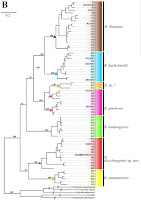 |
| Batrachuperus daochengensis Xiong, Luo & Zeng, 2020 |
Abstract
A new stream salamander species, Batrachuperus daochengensis sp. nov., from southwestern China, is described herein based on morphological and molecular evidence. Molecular phylogeny derived from the mitochondrial gene together with previous nuclear data revealed that B. daochengensis sp. nov. is sister to B. yenyuanensis. The new species differs from all other species of the genus by the following combination of characters: brown horny epidermis on tips of fingers and toes absent; tubercles on palms and soles absent; costal grooves 12; dorsal brown, mottled with blackish spots; fingers 2-3-4-1 in order of decreasing length; tips of longest digits of fore- and hindlimbs largely separated by one to two costal spaces when adpressed towards each other along sides of body. The new species is currently known in the central and southern Shaluli Mountains in southwestern China.
Keywords: Batrachuperus daochengensis sp. nov., Salamander, Taxonomy, Tibetan Plateau, New species
Batrachuperus daochengensis sp. nov.
Diagnosis: The new species of Batrachuperus differs from all other species of the genus by the following combination of characters: brown horny epidermis on tips of fingers and toes absent; tubercles on each palm and sole absent; costal grooves 12; dorsal brown, mottled with blackish spots; fingers 2-3-4-1 in order of decreasing length; tips of longest digits of fore- and hindlimbs largely separated by one to two costal spaces when adpressed towards each other along sides of body.
Distribution and habitat: Batrachuperus daochengensis sp. nov. is currently known from the central and southern Shaluli Mountains (Figure 1A). The new species is an aquatic salamander adapted to cold water environments. The holotype and paratypes were found under stones of small mountain streams at elevations ranging from 4 000 m to 4 100 m a.s.l. The breeding habits of this species are not well known.
Etymology: The name daochengensis is derived from the name of the county where the holotype was collected. We recommend “Daocheng Salamander” as its English common name and “稻城山溪鲵” as its Chinese common name.
 |
| Batrachuperus daochengensis sp. nov. A: Map of southwestern China and sampling sites of the genus Batrachuperus. Chengdu city is presented as a reference point. |
Jian-Li Xiong, Wei Luo and Xiao-Mao Zeng. 2020. A New Species of the Genus Batrachuperus (Urodela: Hynobiidae) from Southwestern China. Zoological Research. 41(5); 589-594.
DOI: 10.24272/j.issn.2095-8137.2020.129


